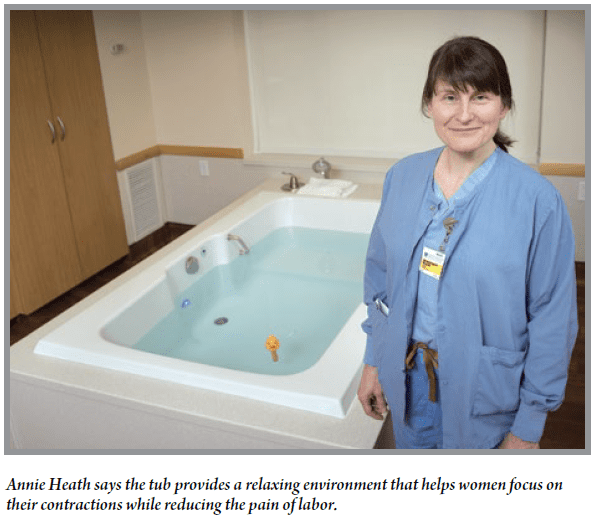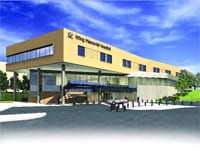Pain Relief, Naturally – Hydrotherapy Tubs Offer Comfort During Labor, Childbirth
Of the adjectives one might use to describe labor and childbirth, calm might not be the first that comes to mind. But there’s no reason, Annie Heath said, why the experience can’t be a little calmer.
Mothers who have experienced the hydrotherapy tub in the Cooley Dickinson Hospital (CDH) Childbirth Center might agree. The one-person tub is equipped with massaging jets that help to relieve contractions and back pain prior to labor.
“The hydrotherapy tub is a great way to provide pain relief during labor, so lots of women find it very comforting and smoothing — a very relaxing, calm environment,” said Annie Heath, a certified nurse midwife.
The tub, with its warm water and soft jets, is intended mainly to reduce the pain of labor, making it a kind of alternative treatment for women who want to avoid anesthesia during the birthing experience, though some do use it in combination with pain-dulling drugs.
“If someone needs anesthesia or analgesia, they might use this instead — or use this prior to having some analgesia,” Heath said, but quickly stressed that the benefits of the tub extend beyond the physical, also reducing anxiety. “It provides very deep relaxation. It’s in a beautiful room with soft lighting, so women can relax in a calm environment, and focus more on their contractions.”
Holyoke Medical Center (HMC), like many hospitals, has provided hydrotherapy during labor for many years. Unlike CDH, however, women at HMC may also give birth in the water.
“It’s been done for decades in this country,” said certified nurse midwife Vanessa Ross, noting that the first documented use of water birthing was recorded in France more than 200 years ago.
“It has been gaining in popularity over the last few decades,” Ross said. “It’s up to the mom to decide if she’s comfortable with the tub. If she’s doing well, if she feels it’s helping her, and we decide she’s a good candidate before getting in, and there are no complications, she can stay in the tub and deliver, although not everyone does.”
Whether using a tub for labor only or all the way through delivery, the benefits are the same, she added.
“It’s mostly to promote relaxation and help her manage the pain of labor — and that includes the pain that comes with the actual delivery. Some studies show that women report greater satisfaction with water birth, and decreased pain.”
Both she and Heath noted that the water provides a sense of buoyancy and ease of movement that appeals to laboring women as well, which contributes to a heightened sense of control.
“When they can move around the water, that feeling of weightlessness is helpful in pregnancy; they can get in different positions more easily in the tub than outside it,” Ross noted. “But it’s mainly for pain. Many women want to have an unmedicated birth and are looking for ways to manage pain that are not pharmacological.”

Freedom and Control
Heath described the room that houses CDH’s hydrotherapy tub as spacious and calming, and said many women are surprised how much they enjoy the experience, but no one is pressured.
“We try to get most people in the tub if they’re interested. We don’t throw them in,” she said with a laugh. “In general, they receive it really well. People in general love to sit in bathtubs, so most of them want to give it a try.”
However, all the women who use the CDH tub are helped out well before the delivery itself. According to Dr. Tucker Kueny, chair of the hospital’s Department of Obstetrics, medical experts do not agree that the benefits of delivery in water outweigh the potential risks to the mother and baby. So, until a broader consensus emerges, Cooley Dickinson’s tub will not be used to deliver babies.
Still, research overwhelmingly supports the benefits of hydrotherapy during labor. A March 2014 report from the American College of Obstetricians and Gynecologists and the American Academy of Pediatrics acknowledged that decreased pain, reduced use of anesthesia, and shorter labors may be positive effects of water immersion during active stages of labor.
“Other hospitals in the area provide water birth,” Heath said. “But we took a little more conservative route. They’re not birthing in tubs, just laboring.”
Holyoke came to a different conclusion, Ross said. “There’s no evidence to support that’s [water birth] is better for the baby, but there’s also no evidence, from the studies we have, that it’s unsafe for the baby, either. We have very good outcomes at our hospital with babies born via water birth. And we have been doing this for a long time.”
To help ensure safety, she added, “we screen patients really carefully, and we have criteria for being eligible for water birth. If someone is having complications or a fever, or there are concerns about the baby’s status, if they have certain communicable infections, if they’re pre-term … there’s a whole variety of circumstances that would keep them from being in the tub. Even for healthy, low-risk women, we very carefully monitor their status and the baby’s status through labor, and a tub birth is an option for them if that’s what they desire.”
As for the moment of delivery itself, Ross said proponents believe a water birth is a gentler way for a baby to enter the world, coming from a sac filled with amniotic fluid into a similar environment with a similar temperature. But they don’t stay in the water long.
“They don’t take a breath before they surface; they have a reflex not to breathe until their face hits the air,” she explained. “But we bring them immediately to the surface of the water, so there’s no risk of aspirating any water.”
Safety First
Cooley Dickinson screens for complications and health risks as well before women are allowed to labor in the tub, said Chief Medical Officer Dr. Mark Novotny. Women for whom an uncomplicated vaginal birth is anticipated and who do not have medical conditions that could pose a risk may choose hydrotherapy while they are laboring. A physician or certified nurse midwife must approve use of the tub, and patients need to sign a consent form — a requirement in all Massachusetts hospitals.
“If a woman says it’s something she would like to do, she has to meet certain criteria,” Heath said. “For the majority of women, it’s fine to be there throughout the labor, then come on out for delivery. But if we have any serious medical concerns for the baby, there might be a risk of being in the tub.”
Women with pre-eclampsia or a suspected infection may not choose hydrotherapy, Kueny said. Other safety protocols include a mechanical lift above the tub so that staff can safely move a woman to a nearby bed who has trouble getting out of the tub or who needs to be moved quickly.
“It’s a very safe process,” Heath said, noting that CDH’s new tub, installed in March, is larger than the old one and features whirlpool-like jets. “There are some things we monitor carefully — for example, the temperature of the water, and we make sure the mother is safe and can get in and out easily. We do monitor and watch them carefully, so the risks are low.”
Ross agreed that safety is paramount, whether a mother at HMC is laboring or delivering in the water.
“We’re always in communication, looking at our policies, making sure we’re up to date,” she said, adding that the hospital is currently looking to enroll in a multi-center study of water birth. “We feel patients benefit from this, and we’d like to be able to contribute to the body of evidence that shows this is a safe and effective option women can use during both labor and birth.”



Comments are closed.